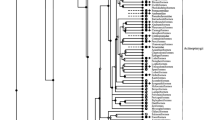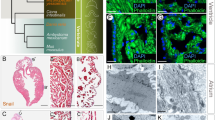Abstract
Starch gel electrophoresis of creatine kinase (CK) isozymes of Xenopus tropicalis shows that at least two different genes code for CK in this diploid (2n=20) species. These genes seem to be orthologous to the CK-A and CK-C genes of extant crossopterygian fish. Additional isozymes may be interpreted either as products of duplicate genes or, more probably, as epigenetically modified forms of the homodimers AtAt and CtCt, respectively. The originally tetraploid species X. laevis laevis (2n=36), which may have arisen by hybridization of diploid ancestors some 30–40 million years ago, has retained expression of all duplicate CK-A and CK-C genes. Differential expression during ontogenesis (CK-A genes) and in different adult tissues (CK-C genes) indicates that divergence occurred not only with respect to the primary sequence of these duplicate genes, but also with respect to the regulation of their expression. In the interspecific hybrid X. 1. laevis × X. tropicalis, all parental CK genes appear to be expressed simultaneously in the heart. However, several subunit combinations cannot be detected on the zymograms.
Similar content being viewed by others
References
Allendorf, F. W. (1979). Rapid loss of duplicate gene expression by natural selection. Heredity 43247.
Ayala, F. J., Powell, J. R., Tracey, M. L., Mourao, C. A., and Perez-Salas, S. (1972). Enzyme variability in the Drosophila willistoni group. IV. Genic variation in natural populations of Drosophila willistoni. Genetics 70113.
Bisbee, C. A., Baker, M. A., Wilson, A. C., Hadji-Azimi, I., and Fischberg, M. (1977). Albumin phylogeny for clawed frogs (Xenopus). Science 195785.
Bozzoni, I., Beccari, E., Luo, Z. X., Amaldi, F., Pierandrei-Amaldi, P., and Campioni, N. (1981). Xenopus laevis ribosomal protein genes: Isolation of recombinant cDNA clones and study of the genomic organization. Nucl. Acid Res. 91069.
Brewer, G. J. (1970). An Introduction to Isozyme Techniques Academic Press, New York and London.
Bürki, E., and Fischberg, M. (1985). Evolution of globin expression in the genus Xenopus (Anura: Pipidae) (accepted for publication in Mol. Biol. Evol.).
Bürki, E., Schwager, J., and Fischberg, M. (1984). Electrophoretic patterns of hemoglobin in different Xenopus species, subspecies and inter-species hybrids. Experientia 4059.
Carr, S. M. (1983). Genetics and Evolution of Mitochondrial DNA in Xenopus (Pipidae), Ph.D. thesis, University of California, Berkeley.
Dawid, I. B., and Blackler, A. W. (1972). Maternal and cytoplasmic inheritance of mitochondrial DNA in Xenopus. Dev. Biol. 29152.
Du Pasquier, L., Miggiano, V. C., Kobel, H. R., and Fischberg, M. (1977). The genetic control of histocompatibility reactions in natural and laboratory-made polyploid individuals of the clawed toad Xenopus. Immunogenetics 5129.
Eppenberger, M. E., Eppenberger, H. M., and Kaplan, N. O. (1967). Evolution of creatine kinase. Nature 214239.
Ferris, S. D., and Whitt, G. S. (1978). Genetic and molecular analysis of nonrandom dimer assembly of the creatine kinase isozymes of fishes. Biochem. Genet. 16811.
Ferris, S. D., and Whitt, G. S. (1979). Evolution of the differential regulation of duplicate genes after polyploidization. J. Mol. Evol. 12267.
Fisher, S. E., and Whitt, G. S. (1978). Evolution of isozyme loci and their differential tissue expression. J. Mol. Evol. 1225.
Fisher, S. E., Shaklee, J. B., Ferris, S. D., and Whitt, G. S. (1980). Evolution of five multilocus isozyme systems in the chordates. Genetica 5273.
Herrera, R. J. (1979). Preferential gene expression of an amylase allele in interspecific hybrids of Xiphophorus (Pisces, Poeciliidae). Biochem. Genet. 17223.
Jaggi, R. B., Wyler, T., and Ryffel, G. U. (1982). Comparative analysis of Xenopus tropicalis and Xenopus laevis vitellogenin gene sequences. Nucl. Acid Res. 101515.
Kahn, J. (1962). The nucleolar organizer in the mitotic chromosome complement of Xenopus laevis. Q. J. Micr. Sci. 103407.
Klemann, S. W., and Pfohl, R. J. (1982). Creatine phosphokinase in Rana pipiens: Expression in embryos, early larvae and adult tissues. Comp. Biochem. Physiol. 73B907.
Nieuwkoop, P. D., and Faber, J. (1967). Normal Table of Xenopus laevis (Daudin) North-Holland, Amsterdam.
Perriard, J. C., Scholl, A., and Eppenberger, H. M. (1972). Comparative studies on creatine kinase isozymes from skeletal muscle and stomach of trout. J. Exp. Zool. 182119.
Scholl, A., and Anders, F. (1973). Tissue-specific preferential expression of the Xiphophorus xiphidium allele for 6-phosphogluconate dehydrogenase in interspecific hybrids of platyfish (Poeciliidae, Teleostei). In Schroeder, J. H. (ed.), Genetics and Mutagenesis of Fish Springer-Verlag, New York, pp. 301–313.
Tymowska, J., and Fischberg, M. (1982). A comparison of the karyotype, constitutive heterochromatin, and nucleolar organizer regions of the new tetraploid species Xenopus epitropicalis Fischberg and Picard with those of Xenopus tropicalis Gray (Anura, Pipidae). Cytogenet. Cell Genet. 34149.
Tymowska, J., and Kobel, H. R. (1972). Karyotype analysis of Xenopus muelleri (Peters) and Xenopus laevis (Daudin), Pipidae. Cytogenetics 11270.
Uyeno, T., and Smith, G. R. (1972). Tetraploid origin of the karyotype of catostomid fishes. Science 175644.
Vonwyl, E. (1983). Expression of the lactate dehydrogenase genes of Xenopus species and interspecies hybrids during early development. Comp. Biochem. Physiol. 76B17.
Vonwyl, E., and Fischberg, M. (1980). Expression of the lactate dehydrogenase genes in Xenopus species hybrids. Dev. Biol. 76505.
Wall, D. A., and Blackler, A. W. (1974). Enzyme patterns in two species of Xenopus and their hybrids. Dev. Biol. 36379.
Westley, B., Wyler, T., Ryffel, G., and Weber, R. (1981). Xenopus laevis serum albumins are encoded in two closely related genes. Nucl. Acid Res. 93557.
Widmer, H. J., Andres, A. C., Niessing, J., Hosbach, H. A., and Weber, R. (1981). Comparative analysis of cloned larval and adult globin cDNA sequences of Xenopus laevis. Dev. Biol. 88325.
Wolff, J., and Kobel, H. R. (1982). Lactate dehydrogenase of Xenopus laevis laevis and Xenopus borealis depends on a multiple gene system. J. Exp. Zool. 223203.
Author information
Authors and Affiliations
Additional information
This work was supported by Swiss National Foundation for Scientific Research Grant 3.775.0.80.
Rights and permissions
About this article
Cite this article
Bürki, E. The expression of creatine kinase isozymes in Xenopus tropicalis, Xenopus laevis laevis, and their viable hybrid. Biochem Genet 23, 73–88 (1985). https://doi.org/10.1007/BF00499114
Received:
Revised:
Issue Date:
DOI: https://doi.org/10.1007/BF00499114




